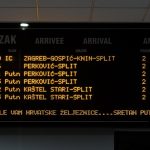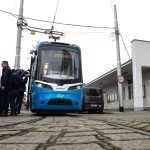August 19, 2019 – Slobodna Dalmacija met with tourism workers in Split to discuss the 2019 summer season and how they would help to improve it in the future.
“Split is full of tourists and has about the same number as last year. Whether it’s a little more or less, no one wants to reveal accurate information. However, what is of interest to us, who work in tourism and live off of it, is to bring in less of the ‘cheaper’ tourists because it would reduce the crowds (which in the peak season are created in the city port), but, with a condition for those tourists who come to us to have higher spending power,” says Đani Ponoš, owner of the rent-a-car and tourist agency “Flarent” with two outlets in the city center – in the port and the nearby Tourist Palace.
What can local and state governments do in this regard?
“In order to get more higher-spending tourists, investors should be able to obtain permits to build better hotels and four-and five-star hotels more easily, so that we don’t have one hundred thousand apartments in Split which are driving down the price of accommodation, bringing in cheaper guests.”
The plans are to have hotels on the East and West Coast.
“The East Coast cannot be solved so quickly, and the Hotel Marjan needs to be remodeled on the West Coast where ships can be moored, as Željko Kerum put it. It would attract really good guests, which would definitely change the image of the city,” Ponoš thinks.
But how much will the best guests be willing to cough up if, in the heat of the season, they have to wait in hours of traffic just to get there?
Ponoš thinks a tunnel is a solution.
“Crowds can be solved with one more exit or entrance to the ferry port. One with a tunnel with an entrance near the station and an exit near the second Police Station in Bačvice, or an entrance and exit through the existing tunnel for Kopilica. Because this metro serves no purpose anyway.”
Ponoš believes the metro tunnel is the solution for another road access.
“A big problem in the season is where to park and the lack of space for car rental agencies to hand over vehicles. Just look at where some taxi drivers disembark passengers, at the pedestrian crossings at the entrance to the ferry port. But for years, there has been a discussion of solving parking problems by building underground garages in the center of Split. But it’s all talk,” Ponoš said.
Ponoš also believes that the local government can’t do anything to solve the problems of the season by next summer.
“Nothing can be resolved quickly. Tourism has been building for years. While everyone in Split is busy in August, the number of guests in the pre-season and post-season through congress and health tourism should increase. We cannot only offer the sun and the sea, so that in winter in Split all hotels are empty, while in Zagorje they are full non-stop,” she adds.
Roko Kačunić, owner of Terminal F at the Tourist Palace, notes that in Split we have about 13 kilometers of beaches, from Žnjan to Marjan, but that we need to sell the destination better.
“This is what hotels will do for us,” emphasizes Kačunić, adding that in the next two years, “Ambassador” and “Marjan” will open, which will bring better guests. He says it was because of the Marjan Hotel that his family owned three catering establishments on the West Riva. But as it took ages for Marjan to undergo renovation, they eventually sold.
But now, the unfinished hotel has been bought by the Adris Group.
“It’s a huge plus for our city. Because this Rovinj company knows how to make a destination. They will make serious money there and do a great job. It will be crazy,” Kačunić adds.
The Split Port Authority plans to move the truck traffic that supplies the islands to a new port in Stinice. Furthermore, customs will be shifted to the breakwater, thus freeing up Gat. Sv. Duje. This is important as it will provide new meters of operational shoreline for mooring ships in domestic traffic. But at the same time, the number of mini-cruisers is increasing, as there are ten more each year.
“I have to commend the Split Port Authority for everything they do and for the effort they have made to give us better places to moor. After regular service, we have priority in Split over foreign yachts. I am now the fifth ship moored parallel to the shore, with two more behind me. For the sake of greater security and comfort of the guests, it would be easier if, at the most, four or five of us were connected,” says Antonio Vuković, commander and co-owner of the Mlini ship.
He adds that small boat companies are developing too fast concerning the infrastructure on the Adriatic and that the crowds in the port of Split can be reduced if the boarding and offloading of guests took place on other days, not just on weekends. However, it is a little harder to execute because of the plans of the agencies, the airlines and the wishes of the guests.
At the taxi stand below the green market, Čedo Pocrnić, a former graphics editor at Slobodna Dalmacija who has worked as a taxi driver in recent years, gave his two sense.
“Local and state governments need to regulate the legal framework that makes it now possible for huge price differences in taxis. The whole evil begins at the airport where the Kaštela and Trogir carriers rob the tourists who land there, and when they arrive in Split, they are afraid to get into a taxi. This is evident on the ground because we have fewer trips,” says Pocrnić, adding:
“Some of my colleagues behave like the rest of society, with the example of those at the top. We are moral in this view because the state has allowed us to charge foreigners as much as 80 kuna per kilometer. It is robbery and it is normal for guests to be upset and scared to ask for the price,” he says and notes that during the hustle and bustle, it is not possible for a taxi to leave the port, though it still costs the passenger in the end.
“While stuck in traffic, the taximeter still runs,” Čedo concludes.
Pocrnić’s colleague, Šime, ho had been a Promet bus driver for 27 years, says that the rulebook by which Minister Butković sent taxi drivers from all over Croatia to Split and Dubrovnik should be changed, because it hijacked passengers from Split concessionaires.
“As if there weren’t enough Uber drivers and other app-based companies. So, in the sun, we fry for two, three hours waiting for passengers,” says Šime, and adds that the commotion in the city was so crazy that, as a result, his passengers often jumped out of the taxi fearing they would be late to board.
Excerpts translated from Slobodna Dalmacija
To read more about travel in Croatia, follow TCN’s dedicated page.








